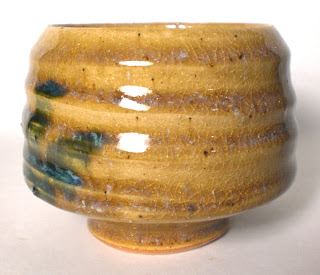
When my wife’s company decided to move her (us) to Cleveland, I had been making pots for over a year and was committed to continuing. Given a tip I called the professor at CSU, Dick Schneider about coming and looking at the facility. He invited me down and the first thing I noticed was the sprawling empire that was the pottery department.
CSU was over 20,000 sq.ft. of space, 3 large Alpine gas kilns, numerous electric kilns, test kilns, wheels everywhere, jolly/jigger equipment, mold making area, slip casting equipment and space for beginning and advanced students. It was a pottery mecca.
Dick was an exceptionally experienced and knowledgable guy. If you could ask it, he could answer it. He had made thrown ware, sculpture, molded ware, gas fired, salt fired, electric fired, this would be a great place to continue learning. I signed up immediately through the continuing education department. His wit and work were engaging and I went from student, to assistant to friend.
If all the world is a stage, CSU certainly personifies that. Besides the normal array of students, there are the advanced students, a rogues gallery. Added to this list is the Continuing Eduction students representing potters looking for a place to work, myself included, to individuals wanting to experience pottery first hand together with the senior citizen brigade who filled out the group. Add to this some real characters like Mike G., Gayle R., John A. and many others and the place was a buzz with every direction and thought process possible. Occasionally John Paolo would come by to do work on the electric kilns. Together Dick and John had more stories than Aesop. It was a great place where the mood was jovial and competitive.
Dick had a corner nook carved out for his private work area in which his wife made pottery as well. Patty made a wide array of highly collected airbrushed thrown and molded ware fired at cone 6 oxidation. In a way, Patty was like a second teacher at CSU as she had started out in stoneware and porcelain and had a vast amount of clay experience. Together, Dick and Patty pushed me away from teabowls and showed me how to make plates & lidded pieces. I was encouraged to try new things, clays, glazes, techniques, ideas, and Dick held my hand through my first attempt at mold making.
Within 6 months at CSU I had become the tech, responsible for firing the kilns, making clay and glazes and generally helping out. Most of the students liked me and I helped a number of them when Dick was gone or too busy. I had a great corner spot to work and access to all the kilns and the variety of temperature ranges the varying students wished to fire too. It was a fertile environment and I learned to use any clay, any glaze and any temperature to make some kind of pottery from Egyptian paste to cone 10 porcelain.
Did I mention one of the perks of CSU? They held sales twice a year that were out of this world. If priced within reason, you could sell everything you could make in a six month period. It was a crazy scene. The doors would open and people would swarm in and collect up large groups of the good, the bad and the ugly. For me, I was able to make back my clay/chemical costs and sell off ideas and directions that I was working toward. It was, simply put, a wonderful time.
Eventually, I knew it was time to move on. I spent about 4 years there and felt it time to set up my own studio with a partner I met at CSU (another long tale that was more than a bit rocky).
To this day, what I still remember fondly about CSU was Dick and his coffee cup that were seldom separated, he was always quick with a story or to tell a joke, but when it came to ceramics, he never steered me wrong.
(Illustrated is a salt fired and fumed large teabowl with amber glaze liner by Dick Schneider from the late 70’s. This is one of my favorite pieces.)






.JPG)






